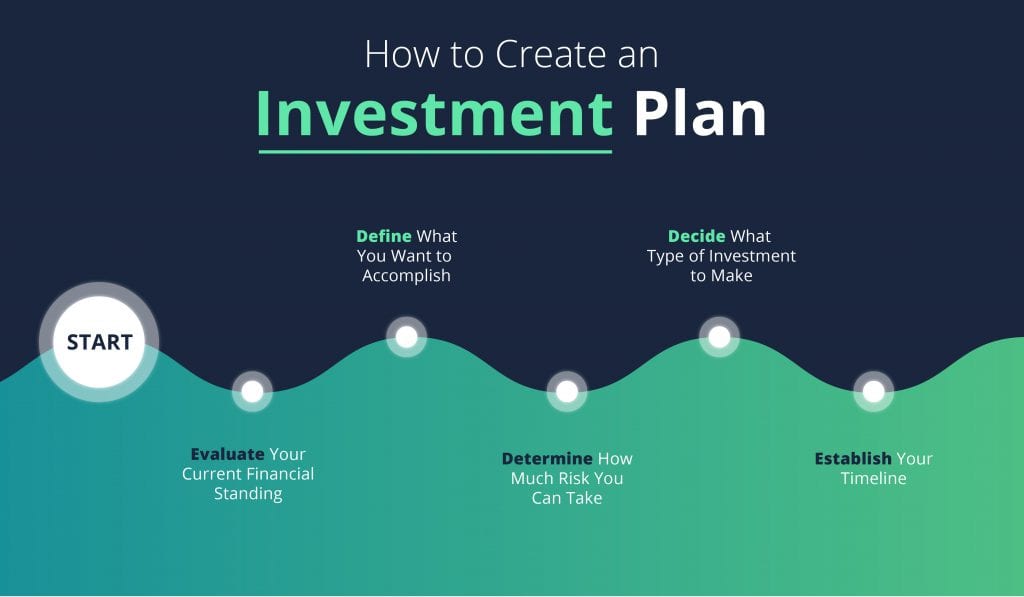Setting budgets and milestones are great, but these efforts are futile if you don’t create an actual investment plan to help you stay on track. It’s one of the most critical steps to meeting your long-term financial goals.
Warren Buffett once said that “An idiot with a plan can beat a genius without a plan,” and this is especially true in investing.
That’s why today, I want to cover how to create an investment plan in 5 simple steps, so you can kickstart your journey and set yourself up for a financially secure future.
So, let’s get started.
Get on Track of Your Financial Goals Download Your Investing Map
Why Investors Need an Investment Plan
If you have never thought of why you want to invest, now is the time. Is it to create a better future for your family, to prepare for retirement, or to create an additional source of income?
You won’t commit to the time and energy it takes to invest if you don’t have a reason to do so.
It’s also important to know why and for what you are investing in because it will influence how and in what you invest. This is the basis of an investment plan.
How to Create an Investment Plan
Now that you’ve done your research, you can create an investment plan that will allow you to move forward and begin investing.
Making an investment plan involves more than just choosing a few stocks to put money in. You have to consider your current financial situation, your goals and timeline, and how much risk you’re willing to take on.
The best investment plan is one that is tailored to you, so I’ll walk you through the steps necessary to create an individualized strategy that will set you on the path to success.
Step 1: Evaluate Your Current Financial Standing
The first step in creating your investment plan is to evaluate your current financial standing and determine how much you have to invest.
What makes up your financial standing? Income, expenses, debt, emergency funds, etc.
When I first started investing, I didn’t have a lot to work with, but every penny went towards my investment portfolio.
Now, this isn’t realistic for everyone, I get it. But, if investing is important to you, it shouldn’t be the last place you put your money. How much can you invest from your paycheck once your basic living expenses are paid?
How Much Should a Beginner Invest in the Stock Market?
Ultimately, you want to invest as much as you possibly can over the course of your life.
With that said, it’s understandable if you want to take things a little slower starting out while you learn the ropes. When I first started out investing I was barely making enough to survive off of and definitely didn’t have a ton of extra cash to throw into the market.
The reality is that even as little as $500can be enough to kickstart a successful investing career. Thanks to compounding interest, $500 can grow into a fortune given enough time.
Most stocks are priced below $500 per share, with many stocks being priced below $100 per share, and today, you can even buy parts of a share of a company’s stock.
While the price of a share alone does not tell you how much of a bargain you are getting the fact that most shares are priced affordably makes it easy for beginner investors to make small investments in the market when they are first starting out.
Invest as much you are comfortable with and invest consistently. If you do this, you’ll be on the right track to building up a healthy sum of money over the long run.
Step 2: Define What You Want to Accomplish
Your short or long-term goals that you want to achieve in your life will impact your investing strategy. Where do you want to be when you retire? Do you want to own a house? Do you want to create passive income? Do you want to create generational wealth for your family?
Defining what you want to accomplish will help you determine how much risk you can take and what type of investments to make that will help you achieve what you want to accomplish in your lifetime.
Step 3: Determine How Much Risk You Can Take
Rule #1 of Rule #1 Investing is to not lose money, but there is always some risk involved when investing in an unpredictable stock market. How much risk can you take based on what you want to accomplish (what we just talked about) and how much time do you have to accomplish it?
If you want to earn money for retirement and retirement is 30 years away, you have a lot of time for your money to grow and recover from economic downturns, so you can afford to be more aggressive. However, if retirement is only a few years away, you will need to make more conservative investments that ensure you will have enough money, but won’t lose it.
How much risk you can tolerate is a personal decision, so give it some thought. It’s not about how quickly you reach your goals but actually reaching them that’s important.
Step 4: Decide What Type of Investment to Make
Next, you need to decide what type of investments will help you accomplish what you have set out to accomplish. There are several different types of investments that you should be aware of before you start investing your money.
But let’s focus on some of the most common types of investments for beginners. These investments include:

Stocks
When you purchase an individual stock, you become a partial owner of the company whose stock you purchased. That means when the company makes money, so do you, and when the company grows in value, the value of your stocks grows as well.
Investing in stocks is by far the most rewarding investment option since it allows you to profit from owning any publicly traded company that you wish to invest in.
On average, the entire stock market grows at a rate of about 7% a year, but it is possible to achieve much higher returns by investing in hand-selected individual companies.
Investment Funds
Investment funds are a basket of stocks that are overseen by a fund manager. While these funds are built and managed by so-called “financial experts”, they typically have a hard time beating the market when you factor in the fees that fund managers charge to those who invest in their fund.
You’ll have a much easier time (and more fun!) learning how to invest your own money rather than relying on some mutual fund manager who can’t beat the market.
Bonds
Bonds can be purchased from the US government or from individual companies. Rather than buying ownership in a company, bonds essentially allow you to “loan” money to the government or to a company in exchange for modest returns. On average, bonds offer a return of 2%-3% per year.
Those returns aren’t great, especially if you’re getting close to retirement and don’t have 40 years to grow your money.
Annuities
Annuities are typically used to supplement retirement income and lock down a steady, monthly payment. They are a contract between an investor and an insurance company where the investor pays a lump sum in exchange for periodic payments made by the insurer.

While annuities may be helpful for some retirees, they are not an ideal investment option for beginner investors.
If you’re curious about what I have to say about other investments such as Penny stocks, bank products, or cryptocurrencies (hint: stay away!) read my blog on the different types of investments.
Step 5: Establish Your Timeline
How long will it take you to start investing?
I know I talk about goals, but these goals are really just the means to the end. The end being the tangible things (amount of money, house, generational wealth, etc.) you set out to accomplish.
I encourage you to make a promise to yourself that you will accomplish that thing and make a plan to go after it.
Your goals are worthless if you don’t commit to them and take action. Write down the action you can take today to take a step toward your end goal.
Bonus Step: Continue Learning Strategies for Beginners
The best investors in the world are constantly reading, researching, and learning.
If you’re interested in learning an investment strategy that works no matter what kind of market we’re in, sign up for my free investing webinar. It’s a 45-minute training that will teach you everything you need to start investing on your own.
If you’d like to see how you stack up against experienced investors, take my Investing IQ Quiz!

Phil Town is an investment advisor, hedge fund manager, 3x NY Times Best-Selling Author, ex-Grand Canyon river guide, and former Lieutenant in the US Army Special Forces. He and his wife, Melissa, share a passion for horses, polo, and eventing. Phil’s goal is to help you learn how to invest and achieve financial independence.
